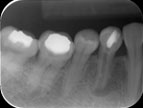- Home
- /
- Our Services
- /
- Other Treatments
OTHER TREATMENTS INVOLVING ROOT CANAL
Cracked Tooth
A cracked tooth is not the same as a fractured tooth: A cracked tooth is an incomplete fracture of the tooth whereas a fractured tooth is a complete separation of the fractured fragments. A crack can involve the deeper structure of the tooth and may propagate into the pulp space. It is usually a vertical crack of the tooth structure that can seldom be observed on the radiograph.
If the pulp tissue is involved, it may result in a toothache. Depending on the extent of the crack, root canal treatment may be required to relieve the patient’s pain.
However, in certain cases, the crack may be very severe and may not be worth the time, effort and cost to save the tooth. The patient may be given the option of extraction and consider other replacement options.
Types of Cracked Tooth Treatment
Treatment options for cracked tooth depend on the patient’s signs and symptoms, risk factors as well as extent and type of crack. A detailed clinical examination by an endodontist is required to determine the most appropriate course of treatment.
Crowning of Cracked Teeth
A crown needs to be placed over the cracked tooth. Part of this procedure involves the tooth being shaved down to create more space for the crown to rest on the tooth. The crown is cemented over the cracked tooth to help prevent progression of the crack.
For teeth with crack tooth syndrome and mild symptoms, we can consider crowning the teeth without root canal treatment. A metal band is first placed around the tooth to see if symptoms can be alleviated without the need for a root canal treatment.
Root Canal Treatment of Cracked Teeth
Root canal treatment will be required if the crack results in more severe symptoms. In such a case, our experts at The Endodontic Office will recommend a root canal to remove the damaged pulp tissue. This procedure is carried out firstly, to determine if the tooth is treatable. If the tooth is treatable, root canal treatment will be continued and completed before fabrication of the crown. The crown is the eventual treatment that can control the progression of the crack.
Extraction of Cracked Teeth
Extraction of the tooth may be the only recourse if the crack extends deep into the roots of the tooth. This might signal that the patient’s tooth is critically damaged.
Root Canal Treatment of an Immature Tooth

Different kinds of trauma to the teeth
How is trauma to the teeth related to root canal treatment
Trauma to the teeth can be explained in 2 broad categories. These are fractures of the tooth structure and loosening of the tooth within its socket. These can happen concomitantly. Both such traumas can affect the pulp tissue and it may degenerate like the way it does in a decayed tooth.
For fractures of the tooth structure, they can be further classified by the type of tooth structure involved. The clinician will need to check the extension of the fracture and determine the need for root canal treatment before placing a full restoration.
For teeth that have been loosened or avulsed from the socket, both the pulp and the surrounding tissue around the roots are affected. The outcome and treatment for the different types of teeth loosening vary and the clinician should explain what the treatments are and the different outcomes of the teeth.
Cracked teeth need to be treated promptly as once the crack has progressed the tooth might end up requiring an extraction instead. Schedule an appointment with our endodontists at the Endodontic Office if you have a cracked tooth.
